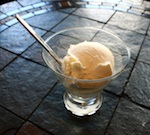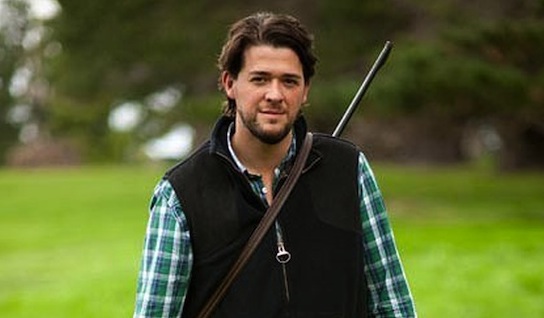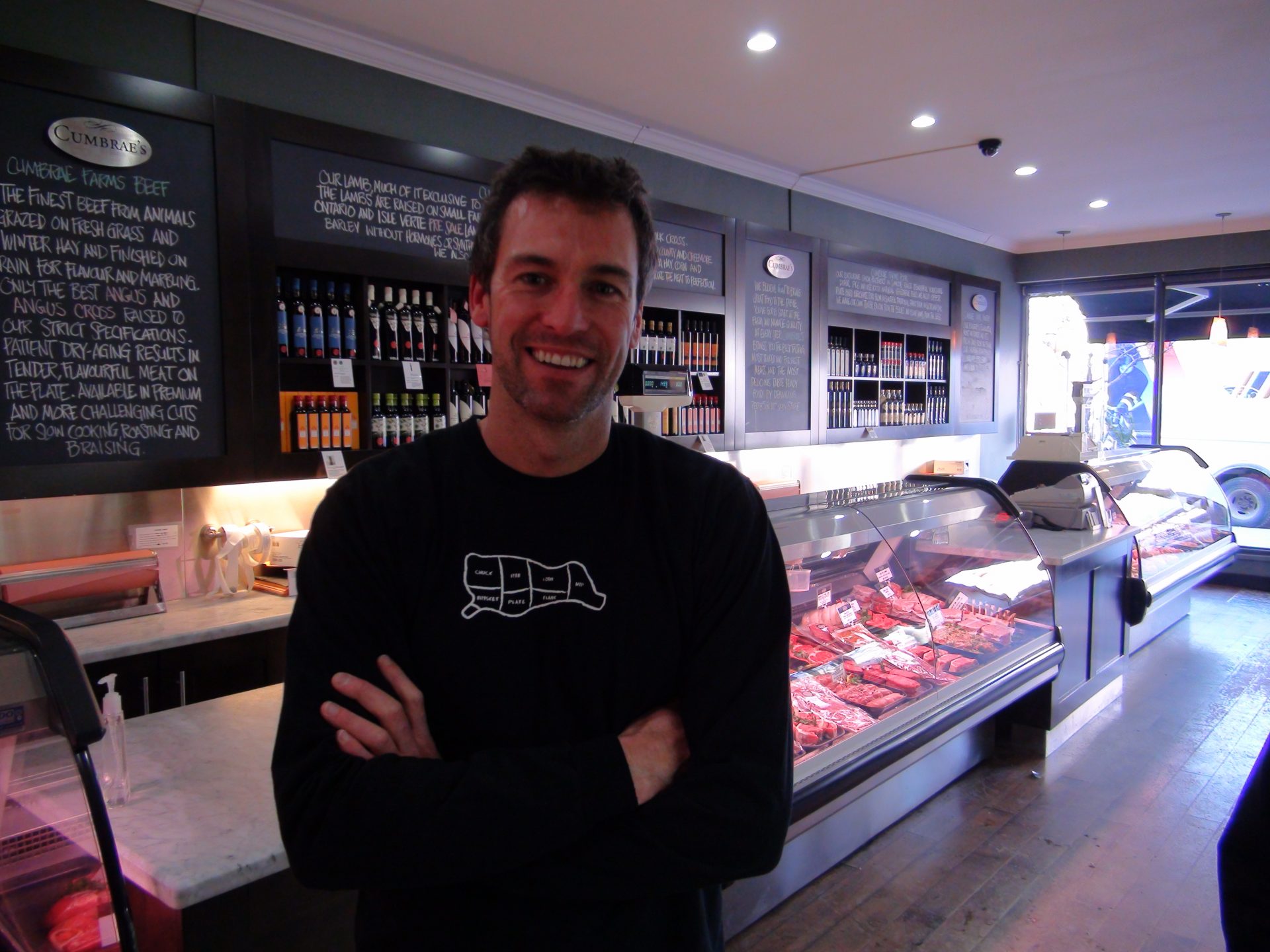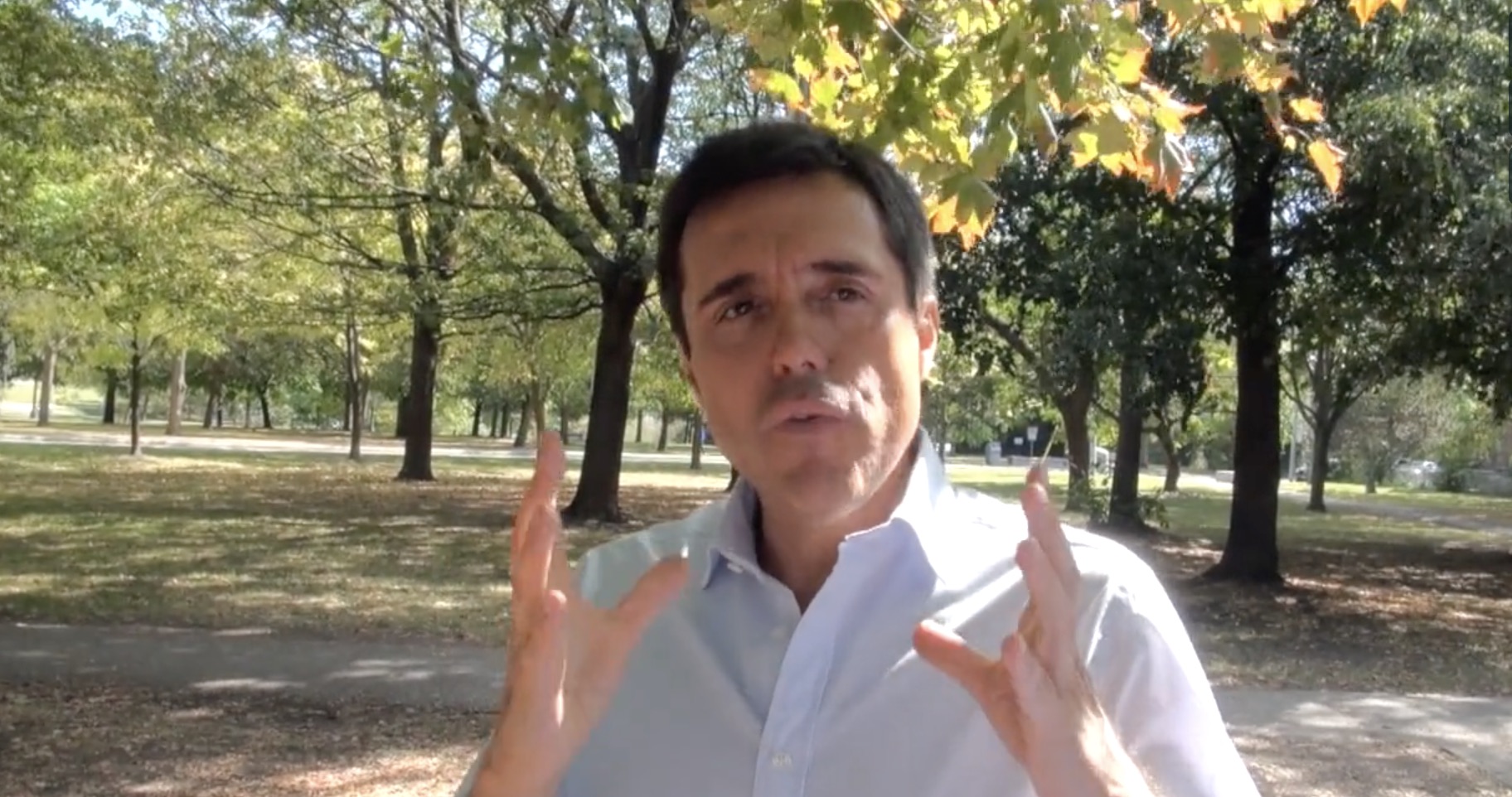by Emily Materick
[This article is the fifth in a series on artisanal ice cream makers, to see all of Emily Materick’s ‘Scoops’, click here – Ed.]
Tucked in amongst the boutiques and fine dining restaurants just north of Eglinton on Yonge is a dark wood fronted shop with a cheerfully retro logo: Jedd’s Frozen Custard . A sparkling chandelier can be spied through the window, giving a clue to the elegance within. Jeddou Ouldcheikhna meets me on the small front patio. He strikes me immediately as a man who is deeply delighted with what he does.
Completely dedicated to replicating a great food memory from his college days, Jedd has brought a unique and compelling product to the city. Although it is not, in fact, ice cream – I could not resist visiting the custard shop and finding out more.
EM: What is the difference between ice cream and custard – what is it and why is it better?
JO: Well, instead of a traditional ice cream mix – this is a custard mix, as if you were making old fashioned custard. There is a lot more eggs, a lot less sugar and there is cream and milk. So the end product is much creamier – that’s one part of it. The second part of it is the process, the highly specialized machines that I use freezes the product at a much faster rate therefore the ice crystals are miniscule. Also, we beat the product slower and there are less air bubbles.
EM: So, it’s a denser product than ice cream, with a smoother texture?
JO: Yes, exactly – but somehow it’s lighter. It’s a very interesting thing! Toronto Life Magazine put it the best way – “it’s a far more luxurious product than it’s more common cousin”. I think that’s a great way of putting it. For me, it was the experience of tasting it – how it hit my taste buds. That’s what the biggest impression on me so many years ago.
EM: How did you get started, what made you want to open the shop?
JO: I came to Wisconsin from North Africa, coming as a student and I went to get an ice cream and it was there! (the frozen custard) I remembered it. It’s not every day that you remember an experience about food like that, an oh my god moment. I said “this is unbelievable ice cream” and they said “it’s not ice cream”. It became a part of my diet and everyone’s around me. When I came to Toronto I realized it wasn’t here – it not everyday you come across an opportunity like that.
EM: Custards are more popular in the United States, right?
JO: Yes, far more popular in the United States. But you know, this is something that’s interesting – when I did my research here I found out that people in Newfoundland call an ice cream cone a custard cone. Its ice cream but they refer to it as a custard cone. There was someone who asked me, isn’t all ice cream custard? They were right in a sense. The base is like a custard, but the way we have it – the freezing process is different and the proportions as well.
EM: The lessened sugar content is interesting to me, that makes a difference with the end product in texture and taste.
JO: The calorie content is the same as ice cream, it’s just the source of the calories are different. It’s a protein source instead of a sugar source. Anyways, that’s why I decided to do it and I’m very happy I did!
EM: Did you try making the custard at home first or just found out the science of it?
JO: What I did was, I did my research and then I contacted experts. You know, the machines are very, very expensive – you can’t just make it at home. So, there was a lot of work – because, you see, frozen custard is not eaten everywhere you go. You can go to a place and have it be almost too creamy, not creamy enough – and there’s obviously personal taste involved. What I wanted was the stuff that made me “wow”. That’s what I was looking for. So we worked on the recipe. First of all, I had to get the machines, which was a nightmare. Having the machines imported into Canada and the anxiety that came along with putting them together. Of course, I had specialists doing all that.
Then we had to find a dairy because no one here makes it (the base mix). There is a dairy in Buffalo that does it but that would be an imported dairy product into Canada which is a whole other thing! I finally found a dairy and explained the concept to them and I gave them my recipe. We ran several options – because it’s a different sort of set up – we finally had a batch that we could sell. The very first batch we sold was about 800 litres. I still felt it needed to have even less sugar in it. It was good, I just wanted less and I reduced the sugar by another 3 percent. They can’t make small batches but I told them it will be fine, let’s just run it – it’s worth it, even if it doesn’t work. It was spot on, it’s unbelievable. The change is imperceptible but it’s there. It’s very complicated!
I got people in from the States to train myself and my staff on taking care of our machines, making our product – and they dealt directly with the dairy as well because, you see, they know a lot more about it than I did.
EM: What are the benefits that you find making desserts on a smaller scale like this?
JO: The flexibility. The freshness, obviously, that’s one thing. You have a lot more control over the ingredients you put into your products. You really can change it, like I mentioned before. The storage, as well, is better. Most of all, people really, really love coming into the store with the machines out and the product right in front of them, being made. I’ve had people say – scoop it for me even before it goes into the dipping container [another name for the metal sleeve that holds the churned ice cream for scooping]. It gave her so much pleasure.
EM: I have to admit, eating ice cream just as it’s coming out of the machine is the best! Somehow it’s just more magical that way. [Laughs]
JO: [Laughs] Magical is the word, you really nailed it. That’s why I purposefully put my machines in the front of the store. They do make noise when they are producing but I wanted my customers to be part of it. I wanted them to feel it, I wanted them to see it. There is a lot to be said for that. I think I have a lot of customers who come in because of that.
Sometimes we run out and we just make another batch. That’s the beauty of it too. I started making seven litres, seven litres, seven litres. We run out and then we just fire up the machine and do it again. In the evenings, I come in sometimes to check the hopper and all the stuff and it’s like a show, people are so interested!
EM: And the reverse question – what are the challenges?
JO: The cost. You know, the cost is really big in terms of the labour. Getting a bunch of buckets of ice cream from a truck, throwing them in the freezer and just scooping them out is completely different. First of all, you have to make sure you get the mix just at the right time. You have to schedule an employee to make it and not every employee can make it good because it’s in the hand, it’s in the control. That’s also something that’s hard. Some days it just comes out wrong. Then, guess what? We have to do it again. We try to make it all by 9am because we start selling it by 10am, all the three flavours. The machine can seize up on you or can just decide it’s not giving you the product [Laughs]. So, that’s another challenge. You know, your threshold for crisis just goes up! [Laughs]
EM: You have chocolate and vanilla as your standard flavours…
JO: I call them my resident flavours.
EM: And you have one that changes all the time. How do usually come up with that flavour? Is there an aspect of customer feedback?
JO: Right now it’s fifty percent customer feedback. I also want my employees to have a sense of ownership. They come up with ideas and they are brilliant, absolutely brilliant. I’ll tell you this story – I came in one day and strawberry was the flavour of the day. Ivy and Liz had made the custard. I come in and they said “Jedd, we did something!” and I said “Ok….what is it?” They said “we made the strawberry but we realized it wasn’t strong enough, we didn’t put enough extract so we just walked across the street to the fruit shop. We bought fresh strawberries and mixed them with the product” I tried it and it was amazing, this is ten times better.
Now they come up with things. That happened as a correction, normally they would have started again, do another batch and change the proportions. It was better because the extract flavour was in the back and you get hit by the natural, fresh fruits. It added more complexity to the texture – I found it unbelievable. So that was the beginning of these young ladies really taking ownership of this and I give them their space. They always know that if they try something and it doesn’t work it only costs us 20 minutes, we can always try again. I am allowing them to have their creative space.
EM: Do you have a flavour that you’ve tried that you really enjoyed but it didn’t sell as well as you thought it would?
JO: No, however I had a flavour I didn’t understand why it sold so well because I don’t really like it. Butterscotch – people love it! I can’t stand it, it’s not for me. I really like, personally, the fruit flavour. I like the tropical fruit flavour that the girls do. They mix strawberries, pineapples and fruit purees into the product at the end. You can’t put anything with any texture into the machine, it would completely kill it. They fold it in after. My real favorite is the smoothie with fresh fruit and the custard, I love that – it’s my breakfast these days.
EM: Do you use any local fruit when you make the fruit flavours, is your dairy organic?
JO: Our milk that we use in the store is organic, we use coffee that is fair trade, organic and shade grown. However, our mix is not organic because it would be too expensive. Our dairy is Hewitt’s Dairy, however which is local, in Ontario. Andrew, who runs it, if I have any questions or any needs I just pick up the phone and he talks to me right away.
EM: Having that personal relationship would be hard with a larger corporate dairy.
JO: You can’t, unless you were really big and I’m not. The fruits, whenever we need them, we get them from the market across the street. Our tea comes from a tea shop three doors down. I try to collaborate with the neighbours around me. I have a discount as well of ten percent for any of the people working at the businesses around me, building a community.
EM: Is there a favorite flavour that you have right now?
JO: For me, its tropical fruit but I really love vanilla. The essence of the frozen custard is the texture and the creaminess. They come out more when it’s naked, naked meaning vanilla – that’s how I like it.
EM: Is there a customer favourite?
JO: They love maple. We did maple on Canada day and people went nuts!
EM: So, finally – cup or cone? Does a cone distract from the flavour of your artisanal product?
JO: It’s the customer’s preference but personally, I eat it from these beautiful glasses we have. For me, it’s part of the experience and I love it. You’re right, when you think about it – the flavour of the waffle cone, in particular, is strong. If it were up to me, I’d use a cup – I’m a cup person, I guess! [Laughs]
 Emily Materick is a writer and the assistant pastry chef at Xococava. A voracious reader of food literature and a maker of tasty things, she also likes capturing those tasty things with her camera.
Emily Materick is a writer and the assistant pastry chef at Xococava. A voracious reader of food literature and a maker of tasty things, she also likes capturing those tasty things with her camera.









Trackbacks/Pingbacks